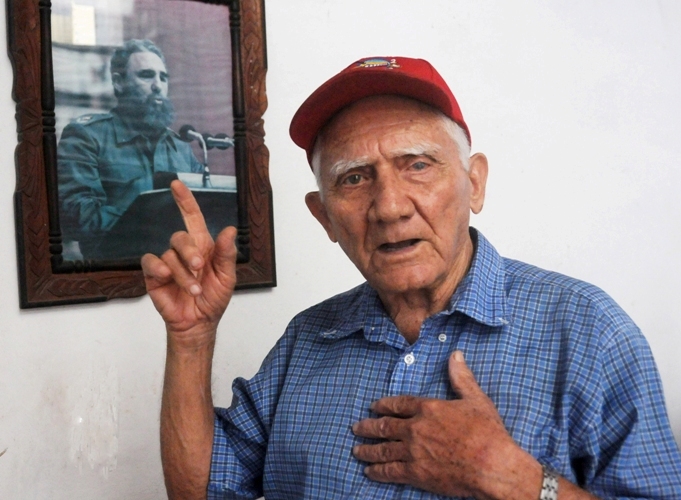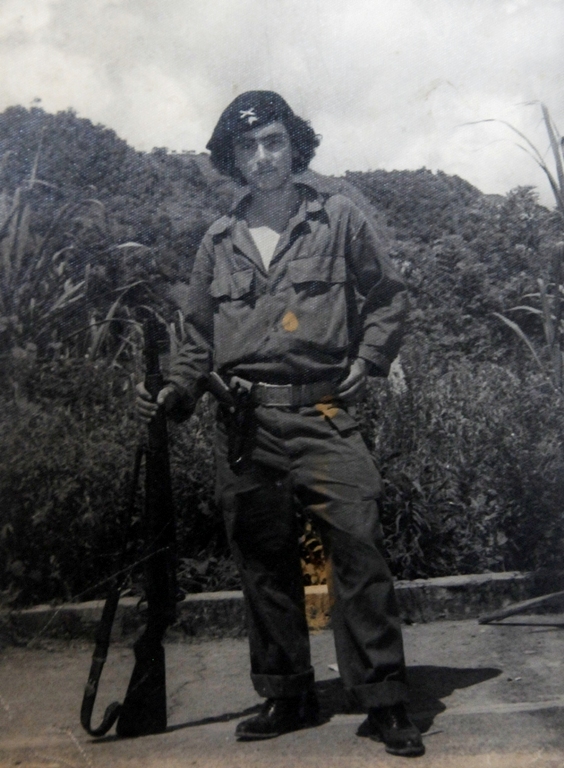
Raúl has very much to tell, not only the events of that central territory of Cuba those that join him to the Heroic Guerrilla Fighter; if only Zurita had been there - and the merit is not small- how would he manage to hoard 39 medals that confirm his patriot's condition? Dressed in blue shirt and pants, in addition to a red cap that covers some white hairs, he prepares to narrate every detail, and we forget of his 78 years of age.
The son finds the photo. "I was thinking that it did not existed already ", says Raúl, and tells: "This is in a place that it is called El Pedrero there in the Escambray. There an agreement was signed between the Directory and the Che, to join the forces. I was 16 years old". Photo: Courteousness of the interviewee. The son finds the photo. "I was thinking that I already not existed", says Raúl, and account: "This is in a place that he is called The Stonecutter there in the Escambray. There an agreement was signed between the Directory and the Che, to join the forces. I had 16 years of age".

Raúl talks of the actions in Santa Clara, the occupation of the fortitude of San Carlos de La Cabaña, the cleaning of the Escambray and his stay in the Caney de las Mercedes - events all associates to the Che -. He confesses to make use of the little that he has left of vision to read the newspapers from the first page up to the last one, and to see all the informative spaces of the television, because he is not a man anchored in the past.
Like speaking about history, if it is done in a colloquial way, it does not imply necessary the chronological order, in the first five minutes of the dialogue the interviewee tells how he and his partners remained impressed that day of November, 1959 when the Che came in a vehicle to the Caney... and at once he "stuck" to work with them.
“Most of the forces of the Rebellious Army had concentrated there, where the construction of the School City Camilo Cienfuegos was initiated. This day we were constructing the roof in one of the buildings. The Che bent the car, seized a barrow and immediately he began to throw it concrete to the work. All the time, he was working with us, in a date that happened to be known like that of the first voluntary work, headed by him”.
Following the "line" of the retrospective, I throw a question.
- How do you come to Santa Clara?
- Fidel had sent the Che to the central part of the country, for the situations that there were happening with the revolutionaries. There was much division between the forces of the Movement July 26 (M-26-7), the Directory and the Second National Front of the Escambray. His mission was to achieve the unit between them and to put himself in control.
“In this time I was involved in the clandestine actions in the municipality of Florida, where I was born, and the people of the M-26-7 took us, me and other young people up to the camp of the Che, which was located in a place called Manacas Ranzola; there was the command.
“When they communicated to him that a few boys had come, he questioned our acceptance, because we were going without weapon and without preparation. Then he sent us for a recruits' school similar to the one that he had directed in Minas del Frío by order of Fidel.
“There we were a little time because the actions of the column were hastening, and in less than three weeks the Capture of Santa Clara was already taking place”, which Raúl qualifies as an action “lightning“, for which speed with which the targets were achieved.
The chief of the Column No. 8 Ciro Redondo exchanges with rebellious officials in Santa Clara. Photo: Taken from vanguardia.cu
Of these days, Zurita also remembers the incident that "embittered" Víctor Bordón. “His subordinates were calling Bordón Commander, but the Che, contradicting this custom, said to him: ' You are not a Commander, you are only a captain'. Time later he assigned him the task of eliminating a light aircraft that was in the airport near to Fomento and was hurting very much to the guerrillas. The success of the operation was such that the Che had to congratulate to Bordón: ' Commander, you fulfilled well the mission'. He was like that”.
Later, on January 3, 1959, the occupation of La Cabaña would come, although Zurita considered himself to be a small "straw" in all this history. For him, the protagonists of the invasion to Occident are the ones who deserve praises because “now it is told very well, but it is not easy to do a walk from the Sierra Maestra under the siege of the forces of Batista and to come to the Escambray in a short period”.
Time earlier, Raúl had traveled to Havana and one day in which he was admiring the seafront along with his brother, that big fortitude of the Batista´s army seemed unassailable to him. “Nevertheless, later we had to enter La Cabaña”. And he keeps on surprising me with the details: "We enter at four o'clock in the morning, for the position 19. There were all the casquitos batistianos (Batista´s soldiers) formed in the polygon of the camp, but we occupy all that, with the Che at the head”.
After an evaluation in which Raúl highlighted the brightness of thought and the consecration of the Heroic Guerrilla Fighter, I interrogate him again.
- Where were you when there was expressed the news about the death of the Che?
- I was in Ciego de Avila, my sister underwent surgery that day and the whole family was in the hospital when the information was realsed. It was fulminating, terrible news, because I thought that the Che was never going to die. I had such a big safety of that, which I could not believe it. When Fidel explained what had happened, then I became convinced. They had rendered useless the rifle that he carried, because while the Che had left a cartridge, he would not be taken prisoner. This way they captured him, hurt in a leg, and later they murdered him by order of the Central Agency of Intelligence.
With the entire certainty of which Raúl Zurita always "returns" to the Che, I say goodbye. To finish our dialogue, he establishes an authorized comparison, saving the geographical distances and of epoch: "The enemy always thinks that with the murder it kills the ideas, and with the Che it happened as with Tucapari, a native of South America, who said before his death: ' Kill me, I will multiply in millions'.
Translated by Linet Acuña Quilez


